
I found this quote on a TeachThought website. It captures the spontaneity, engagement, and creativity of extraordinary education.
Several years ago I attended the closing banquet of our state science teacher conference and overheard two teachers comparing notes in a friendly competition. They had apparently gone through the same teacher development program together. One bragged that 86% of his students had passed the state science standards test at the end of the year. The other claimed that his students had a 93% pass rate, with the implication that having more students pass the test meant that he was the better teacher.
They were both new teachers and I can forgive them their misunderstanding. I felt like jumping into the conversation to remind them that having most of their students pass the standards aligned test only proved that they were standard teachers, when what our children deserve is extraordinary teachers. Unfortunately, there is no state test for extraordinary education.

Is our public education system ailing and in need of reform? Yes, in that it insists on treating each child like a cookie-cutter clone using a one-size-fits-all set of standards.
Would any of us recognize extraordinary education if we saw it? Can we even agree on the characteristics of extraordinary education? For my own definition, I say that students must be deeply engaged in the learning process, with memorable learning opportunities that invite active participation and critical thinking, creative problem solving, collaboration, and communication. In the end, education should have a lasting impact on their lives. And it should be fun, meaningful, and inherently interesting for them!
I learned during my third year of teaching that Project-Based Learning (PBL) can be a powerful route to extraordinary education. I’m not trying to say that I am an extraordinary educator, but I have tried with some success to bring meaningful opportunities to my students. To do this, I have had to look at my course standards in a different way.
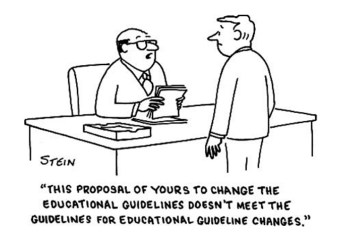
There is a great need to change how we do education, but the forces that resist changes are the teachers and administrators and communities that need them the most. The bureaucracy of our school system is the very thing that holds us back. As one individual teacher, I have to accept that I may not be able to change everything, but I can at least change the way I do things.
The push for standards in education is simple to understand. We don’t want students with gaps in their understanding of the world, nor do we want teachers who are incapable of bridging those gaps. Society needs well-educated people in order for them to make informed decisions. Educational standards were developed to achieve a minimum level of essential literacy and knowledge across all students.
This brings up a deeper question: what constitutes essential knowledge? As one of my college professors put it, is there any knowledge (or skills) that a person must have? Every subject expert has a list of what he or she considers to be the essential concepts of the subject, and the list tends to multiply in any committee put together to consider new educational standards. Heaven forbid that even one math student would not understand the quadratic equation. The world might very well collapse if that happened! So we have to create a standard to address that concern, even if only a minority of teachers hold this opinion.
As a result of this drive toward comprehensiveness, all states have far too many educational standards than are truly necessary for each discipline. In chemistry, is it critically important for students to understand Le Chatelier’s Principle of Reaction Equilibrium? You’ll find it in all the state standards. But is this really necessary for what the student and society need? If taught well, it might help them understand some aspects of everyday chemistry, such as why the Haber process works to produce ammonia or why shaking a warm soda bottle causes the carbon dioxide to spray out. But can they become productive citizens without knowing this? Probably. Why force them to learn what they can easily live without? This has bothered me for years.
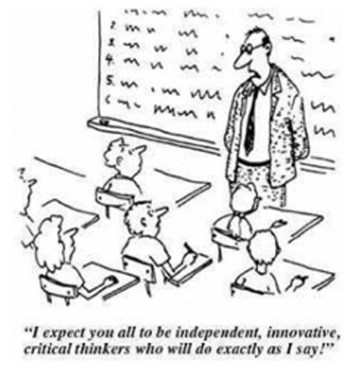
All the shareholders in the education system (parents, children, teachers, administrators, state officials, communities) point the fingers of blame at the others and expect them to be innovative, but are unwilling to change their own viewpoint of what education should be.
What I finally recognized is that standards are meant as a guide to the lowest acceptable level of understanding in a class, not as the final target. Anyone who teaches to the standards alone (especially to the end of year test) will succeed in creating a standard class, an average class, but not an extraordinary one. If we want all of our students to graduate as identical cookie-cutter clones of some “standard” citizen, then standards-based education and the factory model of education will suffice. But if I want students who are strong individuals, creative problem solvers, and innovators, I must go beyond the standards and teach for excellence and quality, not mediocrity. The standards are supposed to be a means to that end, not an end in themselves.
Deeper into Theory
Many of our vaunted education theories support this reductionist view of a subject. For example, Bloom’s Taxonomy is widely used and quoted in educational circles. It poses that there is a hierarchy of understanding and learning; that remembering facts and content details comes first as the foundation of all learning and then leads to understanding, then to application, then analysis, then evaluation, and finally to creativity. The implication is that we need to move our educational activities toward creativity and higher-order thinking skills. The problem with this pedagogical model is that too many teachers never get to the higher-order levels; they get stuck on remembering and regurgitating facts with little real understanding and even less application, analysis, evaluation, or creativity.

Bloom’s Taxonomy, often quoted but poorly understood. Instead of starting at the lowest level (remembering facts) and working our way up, we should start with creativity and work down to facts. Think of this pyramid as flipped upside down, or of creativity being the ground level but the other levels being roots underneath, reaching down to the facts. Students will learn the facts they need if they start with the requirement to create.
So many educational theorists are beginning to propose that Bloom’s Taxonomy should be stood on its head. Creativity should come first, not last. As students create, they can be taught to evaluate the effectiveness and even the aesthetics of their work (more on this in my next post). To do this, they will need to learn to analyze their work in the same way that engineers analyze the effectiveness of their prototypes and models. To analyze the prototype, they have to build it first, which involves the application and understanding of scientific theory. To gain that understanding, students will have to look up and remember the scientific facts and theories involved. In other words, teaching creativity first and insisting on quality work provides the impetus and motivation for students to find the information they need, understand and apply that information well enough to build prototypes, then analyze and evaluate the effectiveness of that prototype against specifications. Students will look up what they need to know because it is necessary for them to solve the problems that occur as they create, build, test, and analyze prototypes. We call this the engineering or design process.
This is where Project-Based Learning (PBL) comes in. Only through extended projects can students have the time, independence, and creativity to deeply explore and understand a subject by following their own curiosity. Projects are the only way to ensure that the intent for having standards is met and that we reach extraordinary education. This happens through what I call “standards overreach.”

It doesn’t make sense to raise standards while lowering the resources available to schools to reach those standards. There’s nothing quite like an unfunded mandate.
Standards Overreach:
Let me start with an example. During the first week in my first year biology classes, I introduced the concept of the characteristics of life and the abiotic factors necessary to sustain it. This is a common biology standard in most states. Now if I were a standards-obsessed teacher, I would teach to this point as my target for student understanding. I might put up a list of terms and have students write down definitions in the hope that they will understand them. This is a low-level activity without much student mental engagement. They’ll forget these definitions as soon as the test is over, if they retain them even that long. I might write the terms on a worksheet and have them look up definitions. Slightly better but still boring for everyone concerned, although it does meet the standard. I could show them a video about it and have them take notes. A bit better but still teacher-centered and passive for students. I could have students brainstorm the characteristics of life, then ask them to provide examples, or do a lab activity, etc. Getting better but still not entirely effective.
What all of these activities have in common is that they are targeted specifically to this one standard alone, and on the end of unit test, only some of the students will show understanding (or at least regurgitation). I have only partially succeeded.

What kind of life forms could exist on an exoplanet or exomoon, such as shown here? As students ask and answer such questions, they come to understand the characteristics of life and the abiotic factors that support it.
Or I could do this in a completely different way through a student-centered, engaging project. I could have them go beyond the standard (overreach it) knowing that at minimum they will understand the standard and possibly much more. So I use my passion for astrobiology and experience conducting field research studies of extremophiles in the Mojave Desert to create a project for my students. We’ll collect halophilic bacteria from the Great Salt Lake and let them grow in a Winogradsky column then analyze the pink floaters under a microscope. We’ll extend this to research on other extremophiles and use real examples of how they are adapted to their environments, with students developing posters or presentations or other summary products of their choice. Do all forms of life on Earth need oxygen, or even air? No – there are lithoautotrophs that live in rocks and get carbon dioxide from minerals, not air. Does all life require light and plants at the bottom of the food chain? No. Look at the chemosynthetic bacteria that are at the bottom of the food chain near deep ocean hydrothermal vents.
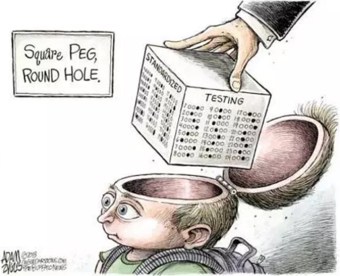
How can one test measure the quality or extent of knowledge for every student, even if the tests are adaptive? How can a single measure determine the effectiveness of every teacher?
Then they’ll look at potentially habitable exoplanets (and learn a bit of astronomy and physics on the way) and choose an actual planet, then develop a drawing or clay model of an alien life form they envision, complete with descriptions of how it is able to survive in that environment, the abiotic factors that exist there, and the ecosystem it is part of. How does it eat or get energy? How does it move around, reproduce, adapt to changes, grow and develop, etc.? How would we detect it and know that it is alive?
As a capstone event or product, they produce posters or other products on their research into and present them at a science showcase night, just as if they were professional scientists at a conference. At the end of the evening we can watch and analyze the realism of the movie “The Andromeda Strain.” In the process of thinking all of this through, the students will deeply understand the characteristics and factors necessary for life. They will all easily meet the standard because we shot way beyond the standard.
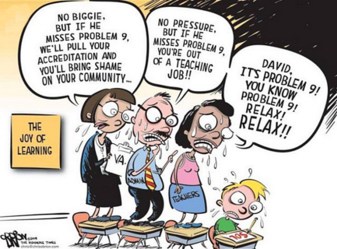
With high stakes testing supposedly measuring the effectiveness of teachers and schools based on how students take the test, its no wonder teachers are teaching to the test. Their jobs are on the line. Yeah. No pressure . . .
You will argue that this type of project will take days to complete, when you can cover that standard in just one day. Maybe so, but we haven’t just covered that one standard. Without my having to lecture them, my students have learned about evolution and classification, microbiology and using a microscope, physics and astronomy, and even developed artistic skills. They have learned about scientific communication, which is part of one dimension of the Next Generation Science Standards. We have therefore touched on about ten other standards from multiple disciplines in the five days of this project. If I tried to teach each one of those standards one at a time, it would take far longer than our project did. My students’ understanding will be deeper and more permanent than any lower-level unengaging assignments can achieve.

No Child Left Untested . . . How can teachers possibly meet education standards when they have to spend all of their teaching time administrating tests to measure how well they are meeting education standards?
Meeting Standards through PBL:
Here is another example that we completed just two weeks ago. We had moved into our units on human anatomy in my biology classes. I wanted students to learn the function of muscles and bones and how they provide support and movement. Now the “standard” way of doing this would be to provide diagrams of the skeleton and muscles and have students label all the names of all the part. Tibia. Fibula. Patella. Femur. Pelvis. Clavicle. Sternum. Latisimus Dorsi, Deltoid, etc, etc, ad nauseum. And many teachers leave it at that, with no understanding of how it all works together. Some will go on to teach (or more likely have the students read in the textbook) how flexor and extensor muscles must be paired, how they are anchored to the fixed bone with tendons reaching across the joint to the mobile bone. But only a few teachers will have students apply this knowledge, or design experiments to collect data that can be analyzed, or have students think critically to evaluate the quality of their knowledge, or do something creative with it.
So I turned the process on its head. I did draw a diagram of the elbow joint on my whiteboard as an example, showing and labeling the parts of everything. I explained how the bicep and tricep work in tandem to flex and extend the joint, and how ligaments, cartilage, and all the other parts hold it all together and allow it to move. That was all I did, and I didn’t really need to do that. It was just a quick 15-minute introduction. Then I gave them a challenge: using the materials I provided, they had to build a mechanical arm that would duplicate the movement of the elbow joint. As teams, they would need to use my diagram as a guide, look up whatever other information they needed, then design and build their own arm. It had to meet certain specifications: It had to have the same range of motion as a regular arm, not bending too far or extending too far (it could not be double-jointed). It had to have a way of both flexing and extending the forearm. And that was it.
I provided lots of cardboard, wooden skewers, beads, string, hot glue guns and glue sticks, etc. I divided the students into three-person teams, and required them to show me a sketch of their plan before they were allowed to collect materials. Then they set to work. In every case, their first attempts didn’t work very well. Some of the students wanted to quit at that point, saying that this task was “impossible,” but I provided encouragement and hinted that they should look more closely at how the actual human arm does this; obviously, it isn’t impossible if our arms can do this. They tore parts off their models, reglued, tried again, and eventually all the teams succeeded. They were all different, but all mimicked the construction of the human arm in important ways.
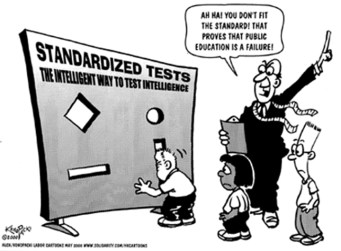
Standards imply that every student is the same, and that one size fits all in education.
With that project done, the same teams went on to create working models of the human hand. These models had to be able to create several gestures of my choice to show control of individual fingers, be able to pick up and move small objects to show dexterity, and be able to grasp and lift a cup full of water (added slowly) to demonstrate strength. This was a much harder task, and the same students again tried to give up. They wanted me to provide step-by-step instructions, but I refused. I repeated that there were no right answers, no one right way to do this. Some had to redesign from scratch, which was frustrating, but they overcame this frustration and eventually all succeeded.
It took seven class periods to accomplish these two projects. I could have easily taught the basic concepts about the arm and hand in a day using traditional activities, and they might have remembered the details long enough to pass the unit test (with some repetition and review). This would have sufficed for the requirements of the state standards. But it doesn’t meet my own standards, which are much higher. And it meets those other two pesky dimensions of the Next Generation Science Standards: Scientific and Engineering Practices (engineering design process) and Cross-Cutting Concepts (modeling). We’ll look at teaching through building models in a future post.
So how did they do upon assessment? On the unit test, the students who completed these models showed a thorough understanding of how the arm and the hand work; not just the parts, but how they are shaped, how they operate and fit together, and even the importance of having opposable thumbs. Those teams that didn’t have effective thumbs had great difficulty lifting their cup of water.
All students received 100% on the essay questions related to these projects and all passed the test. They could repeat the facts, and they thoroughly understood the concepts. They will remember their learning far longer than traditional methods because they have applied their knowledge. They have analyzed problems that occurred with their models and evaluated their effectiveness against the specifications. They have revised, fixed, redesigned, and in short, they have created. They fulfilled all of the requirements for the state and the three dimensions of the NGSS, as well as all of Bloom’s levels. In addition, they learned resilience, teamwork, collaboration, and communication skills. Not all of the teams got along perfectly, and I had to work with them on how to communicate effectively to listen to all ideas and make a solid group decision instead of one person trying to run the show. Was it worth the extra time? Absolutely!
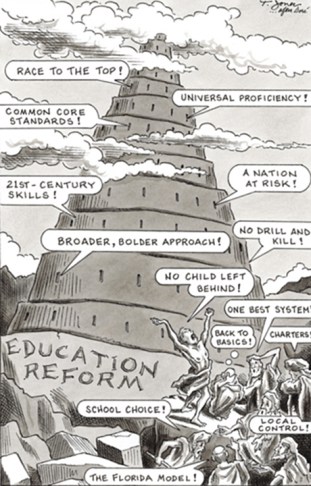
There are a lot of education buzzwords out there, a veritable Tower of Educational Babel that obscures instead of clarifying the problems of education and the need for reform.
Conclusions:
When administrators and parents and everyone else gets bent out of shape about standards and you feel a pressure to “teach to the test,” just remember that state education standards are the minimum expectation, and we should hope that you are a better teacher than that. Yes, you must meet the standards. You can get fired if you don’t. But state standards are not the end we are after, only one means to the better end of extraordinary education. So overreach the expectations forced upon you by your state, principle, or community and dare to teach to a higher standard. Mentor your students to deeper understanding, higher engagement, and further creativity. Dare to be extraordinary!